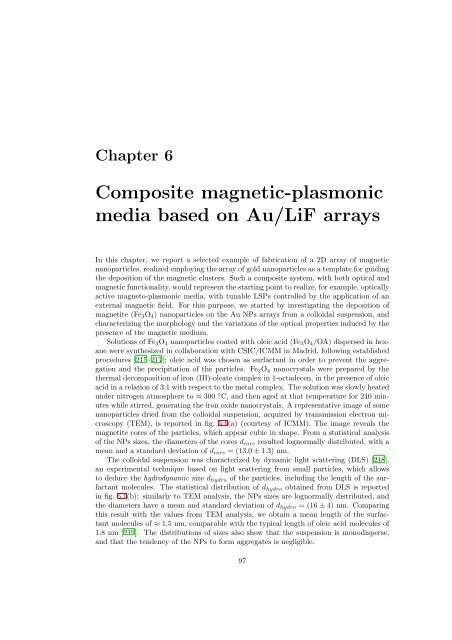Morphology and plasmonic properties of self-organized arrays of ...
Morphology and plasmonic properties of self-organized arrays of ...
Morphology and plasmonic properties of self-organized arrays of ...
Create successful ePaper yourself
Turn your PDF publications into a flip-book with our unique Google optimized e-Paper software.
Chapter 6Composite magnetic-<strong>plasmonic</strong>media based on Au/LiF <strong>arrays</strong>In this chapter, we report a selected example <strong>of</strong> fabrication <strong>of</strong> a 2D array <strong>of</strong> magneticnanoparticles, realized employing the array <strong>of</strong> gold nanoparticles as a template for guidingthe deposition <strong>of</strong> the magnetic clusters. Such a composite system, with both optical <strong>and</strong>magnetic functionality, would representthestartingpoint torealize, for example, opticallyactive magneto-<strong>plasmonic</strong> media, with tunable LSPs controlled by the application <strong>of</strong> anexternal magnetic field. For this purpose, we started by investigating the deposition <strong>of</strong>magnetite (Fe 3 O 4 ) nanoparticles on the Au NPs <strong>arrays</strong> from a colloidal suspension, <strong>and</strong>characterizing the morphology <strong>and</strong> the variations <strong>of</strong> the optical <strong>properties</strong> induced by thepresence <strong>of</strong> the magnetic medium.Solutions <strong>of</strong> Fe 3 O 4 nanoparticles coated with oleic acid (Fe 3 O 4 /OA) dispersed in hexanewere synthesized in collaboration with CSIC/ICMM in Madrid, following establishedprocedures [215–217]; oleic acid was chosen as surfactant in order to prevent the aggregation<strong>and</strong> the precipitation <strong>of</strong> the particles. Fe 3 O 4 nanocrystals were prepared by thethermal decomposition <strong>of</strong> iron (III)-oleate complex in 1-octadecen, in the presence <strong>of</strong> oleicacid in a relation <strong>of</strong> 3:1 with respect to the metal complex. The solution was slowly heatedunder nitrogen atmosphere to ≈ 300 ◦ C, <strong>and</strong> then aged at that temperature for 240 minuteswhile stirred, generating the iron oxide nanocrystals. A representative image <strong>of</strong> somenanoparticles dried from the colloidal suspension, acquired by transmission electron microscopy(TEM), is reported in fig. 6.1(a) (courtesy <strong>of</strong> ICMM). The image reveals themagnetite cores <strong>of</strong> the particles, which appear cubic in shape. From a statistical analysis<strong>of</strong> the NPs sizes, the diameters <strong>of</strong> the cores d core resulted lognormally distributed, with amean <strong>and</strong> a st<strong>and</strong>ard deviation <strong>of</strong> d core = (13.0±1.3) nm.The colloidal suspension was characterized by dynamic light scattering (DLS) [218],an experimental technique based on light scattering from small particles, which allowsto deduce the hydrodynamic size d hydro <strong>of</strong> the particles, including the length <strong>of</strong> the surfactantmolecules. The statistical distribution <strong>of</strong> d hydro obtained from DLS is reportedin fig. 6.1(b): similarly to TEM analysis, the NPs sizes are lognormally distributed, <strong>and</strong>the diameters have a mean <strong>and</strong> st<strong>and</strong>ard deviation <strong>of</strong> d hydro = (16±4) nm. Comparingthis result with the values from TEM analysis, we obtain a mean length <strong>of</strong> the surfactantmolecules <strong>of</strong> ≈ 1.5 nm, comparable with the typical length <strong>of</strong> oleic acid molecules <strong>of</strong>1.8 nm [219]. The distributions <strong>of</strong> sizes also show that the suspension is monodisperse,<strong>and</strong> that the tendency <strong>of</strong> the NPs to form aggregates is negligible.97
















